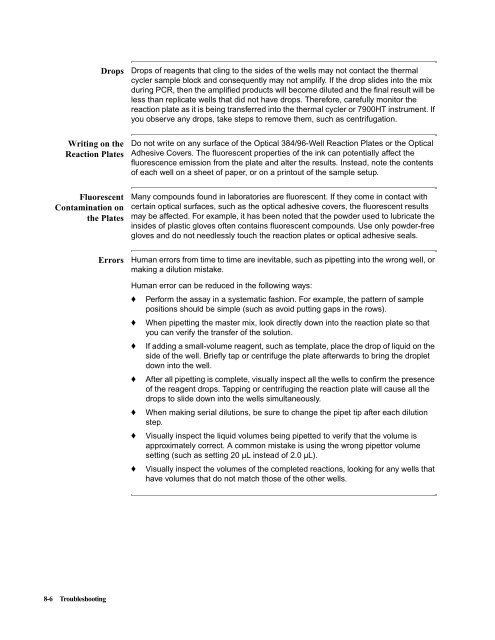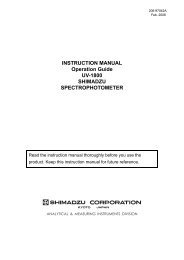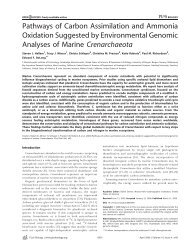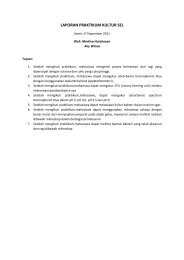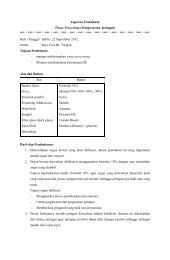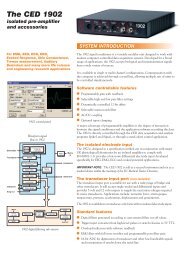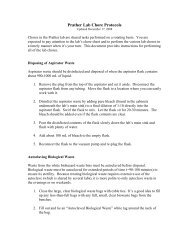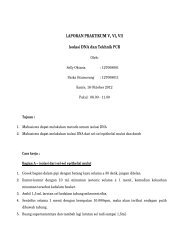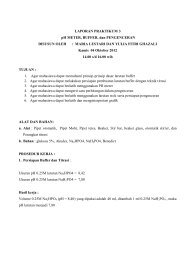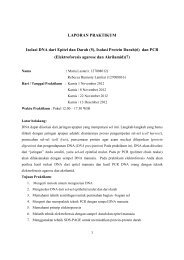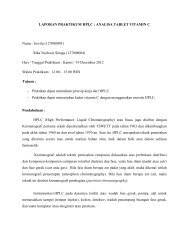ABI Prism® 7900HT Sequence Detection System ... - OpenWetWare
ABI Prism® 7900HT Sequence Detection System ... - OpenWetWare
ABI Prism® 7900HT Sequence Detection System ... - OpenWetWare
Create successful ePaper yourself
Turn your PDF publications into a flip-book with our unique Google optimized e-Paper software.
Writing on the<br />
Reaction Plates<br />
Fluorescent<br />
Contamination on<br />
the Plates<br />
8-6 Troubleshooting<br />
Drops Drops of reagents that cling to the sides of the wells may not contact the thermal<br />
cycler sample block and consequently may not amplify. If the drop slides into the mix<br />
during PCR, then the amplified products will become diluted and the final result will be<br />
less than replicate wells that did not have drops. Therefore, carefully monitor the<br />
reaction plate as it is being transferred into the thermal cycler or <strong>7900HT</strong> instrument. If<br />
you observe any drops, take steps to remove them, such as centrifugation.<br />
Do not write on any surface of the Optical 384/96-Well Reaction Plates or the Optical<br />
Adhesive Covers. The fluorescent properties of the ink can potentially affect the<br />
fluorescence emission from the plate and alter the results. Instead, note the contents<br />
of each well on a sheet of paper, or on a printout of the sample setup.<br />
Many compounds found in laboratories are fluorescent. If they come in contact with<br />
certain optical surfaces, such as the optical adhesive covers, the fluorescent results<br />
may be affected. For example, it has been noted that the powder used to lubricate the<br />
insides of plastic gloves often contains fluorescent compounds. Use only powder-free<br />
gloves and do not needlessly touch the reaction plates or optical adhesive seals.<br />
Errors Human errors from time to time are inevitable, such as pipetting into the wrong well, or<br />
making a dilution mistake.<br />
Human error can be reduced in the following ways:<br />
♦ Perform the assay in a systematic fashion. For example, the pattern of sample<br />
positions should be simple (such as avoid putting gaps in the rows).<br />
♦ When pipetting the master mix, look directly down into the reaction plate so that<br />
you can verify the transfer of the solution.<br />
♦ If adding a small-volume reagent, such as template, place the drop of liquid on the<br />
side of the well. Briefly tap or centrifuge the plate afterwards to bring the droplet<br />
down into the well.<br />
♦ After all pipetting is complete, visually inspect all the wells to confirm the presence<br />
of the reagent drops. Tapping or centrifuging the reaction plate will cause all the<br />
drops to slide down into the wells simultaneously.<br />
♦ When making serial dilutions, be sure to change the pipet tip after each dilution<br />
step.<br />
♦ Visually inspect the liquid volumes being pipetted to verify that the volume is<br />
approximately correct. A common mistake is using the wrong pipettor volume<br />
setting (such as setting 20 µL instead of 2.0 µL).<br />
♦ Visually inspect the volumes of the completed reactions, looking for any wells that<br />
have volumes that do not match those of the other wells.


